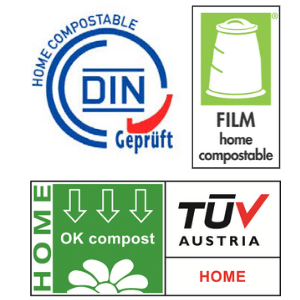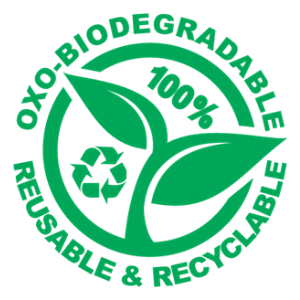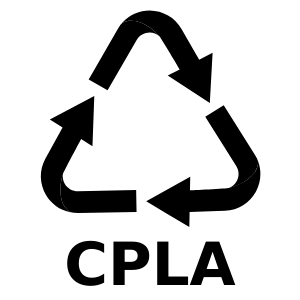Bioplastics
A plastic revolution or a load of rubbish?
What are bioplastics?

Compostable bioplastics have been touted as the solution to our single-use, throw-away lifestyle, allowing consumers to enjoy takeaway coffees guilt-free. But guess what? Turns out, it’s not that simple.
The issue of bioplastics is complicated – not only for consumers, but also for many small businesses that have been trying to do the right thing by making the switch from plastics to bioplastic alternatives.
Although interpreted and sometimes marketed as such, compostable plastic takeaway packaging wasn’t actually designed to be the solution to plastic pollution. In reality, it was designed to prevent food waste being contaminated with plastic packaging, as one of the original compostable packaging producers, Vegware, explains here: “Whilst Vegware’s plant-based disposables are designed to replace oil-based plastics in a foodservice setting, compostable packaging is not the solution to marine pollution”*.
Types of bioplastics

To be called a bioplastic, a product has to be either biodegradable or made from plant-based materials. But being made from a plant doesn’t mean a product will degrade like a plant, and being biodegradable doesn’t mean a product will break down with food waste in the kitchen. In reality, most bioplastics need to be composted at very high temperatures over several weeks in an industrial composter.
The phrase ‘biodegradable’ is often used in connection with bioplastics, but this can be misleading because most of us think biodegradable means what happens to an apple core in the ground. Instead, for a bioplastic to be described as biodegradable it needs to pass the EN13432 test for industrial composting – so not at all like an apple core!

Compostable plastics (commonly labelled as PLA)
A polylactic acid derived from the sugar and starches of plants, most commonly corn starch and sugar cane. PLA is the clear bioplastic often used in salad and deli food boxes and as a liner in coffee cups and sandwich boxes. PLA will break down within 90 days in an industrial in-vessel composter running at 60 degrees. In order to be compostable it has to be tested and meet the criteria of EN13432.

Home compostable plastics
If you see the home compostable sign it will most likely be the original bioplastic, cellophane, which is made from cellulose derived from wood pulp. Cellophane will degrade within 28 to 60 days in a home composter at 20-30 degrees. Check for the home composting symbol to avoid contaminating your compost heap. To be clear – home composting isn’t the same as your council food caddy, which usually undergoes a different kind of composting process.

Oxydegradable plastics
These are sold as bags and straws and are really petroleum-based plastics that break down into lots of little pieces. Yes, that’s right, they’re actually designed to turn into microplastics – not as earth-friendly as they sound! The EU Environment Committee is demanding a ban on these by 2020. And quite rightly so.

CPLA
Like PLA but with added chalk. CPLA is used to hold food products that need to tolerate high heats: things like cutlery, coffee–cup lids and dishes for serving hot food. As with PLA, it needs to be broken down in an industrial in–vessel composter.
New Materials

New materials are being introduced all the time, such as cassava root and thistle starch bags, or water-soluble bioplastics made from seaweed. But with all these materials it’s important to understand how long they take to degrade and what conditions they need. Sadly, most plastic packaging that ends up in a food waste bin will get pulled out for incineration before it has even had a chance to break down.
Non-compostable bioplastics
Hemp and sugarcane have been used to mimic the structure of fossil fuel-based plastics. These bioplastics are used for applications such as car parts or water bottles. Green HDPE is made from sugarcane and can be recycled like HDPE.
Water-soluble bioplastics
Made from seaweed. These bioplastics are used to make drinking balls such as Ooho balls that were trialled at the London Marathon 2019, and are also being developed in Indonesia for washing liquids and food sachets which break down in water.
To bin, or not to bin

The second big issue is that we don’t currently have significant infrastructure to compost bioplastics in the UK. The industrial composters that can break down compostable plastics are called in-vessel composters and there are currently only around 18 in the UK. These sites only accept waste that’s guaranteed not to be contaminated by oil-based plastics, which means the shipments need to come from closed environments (like festivals) which can guarantee the plastics have been kept separate. Some café’s are offering take-back schemes to enable this too.
This leaves us consumers in a plastics pickle. Compostable bioplastics look exactly the same as oil-based plastics, so they often end up in the food bin or the recycling bin when actually, the only household bin they can go in is the general waste bin. Yes, that’s right, we’re expected to understand that ‘compostable’ doesn’t mean we can actually compost them. As clear as mud.
What’s your relationship status with bioplastics?

A load of rubbish?

What all this means, is that while bioplastics might sound good, they are still a single-use material and there are extremely limited options to compost them. Ultimately, due the nature of when we tend to use bioplastics – as take–away food containers and packaging – they end up in the bin and consequently in landfill. The other issue is that as they don’t biodegrade outside of certain conditions they can still contribute to marine pollution if they become litter.
If compostable plastics are to become a viable alternative to oil-based plastics, there is a lot of work for the bioplastics and waste industries to do so they can better work together.
Our advice at City to Sea remains that refusing plastic and any single-use is the only solution. So choosing to refill and reuse are the best options. If your local cafe is using bio-plastic packaging, then treat it as you would traditional plastic and take your own reusable alternatives.
Download the Food-To-Go report now
Here’s everything you need to know about bioplastics
So what am I supposed to do with them?
If the bioplastic items are home-compostable and you have a compost bin in your garden, put them in there. Otherwise, any compostable plastics need to go in your general waste bin. This will mean they will go for waste to energy incineration or landfill. And yup, they won’t get composted. So there you have it, even when something says its compostable chances are it won’t be!
We’ve unpicked some of the questions we are most frequently asked about bioplastics. If you’ve got a question we haven’t covered please get in touch and we’ll do our best to answer it!
Can bioplastics go in the food bin at home?
Unfortunately not. Most household food waste is composted at anaerobic digester plants, which work without heat or oxygen and can’t break down solid packaging like your compostable food bag. This means any packaging gets pulled out for waste-to-energy incineration.
Even if your food waste caddy goes to one of the 27 plants in the UK that accept compostable plastics that accept compostable plastics, they wouldn’t know it isn’t an oil-based plastic (there isn’t a person vetting every non-food item), so it would get removed.
What are the compostable packaging companies doing to support their materials being composted?
The company Vegware is working on a couple of schemes to get ‘their’ compostable plastics to a composting facility that will accept them. The Composting Collective supports large institutions and cafés to get their packaging to a local in-vessel composter, at a cost. For individuals they have a post-back scheme, so people pop their materials in a box and return at a cost to the individual of £20.
But these two schemes are only for Vegware products as these are the ones that the composting facilities have approved, as many others don’t breakdown as well as they claim to.
Can bioplastics go in with the recycling?
No, they are designed for composting, not recycling. PLA has a number 7 on the bottom which may lead you to believe it is recyclable – but it isn’t. Don’t be misled! The number 7 is for ‘other materials’ which are not recyclable, so they shouldn’t go in the recycling bin.
What happens if bioplastics do go in the recycling bin?
At present, plastic recycling facilities haven’t started using the technology enabling them to differentiate between PLA and PET plastic, as currently there are not high enough volumes of compostables to justify investing in it.
There are concerns that bioplastics will reduce the quality of oil-based plastic recycling, as the polymers and materials are different. However, it has been suggested by some studies that the volumes of compostable materials getting into the recycling waste stream are still low.
German and Italian studies have suggested that recycled content would not be affected by up to 3% PLA in Polypropylene (PP), and 1-2% in recycled PET.
Surely sending bioplastic to landfill is better than ordinary plastic? won't it decompose eventually?
Unfortunately, the conditions aren’t hot enough. Plus no waste decomposes in a landfill, because of the combinations of materials compacted on top of each other. So even compostable plastics will remain as they are in landfill, like the rest of the waste.
Many people have asked whether compostable plastics give off methane in a landfill like other organic materials. The answer is no because they need to reach 60 degrees before they start decomposing, so they just remain inert.
Shouldn't bioplastics be phased out with problematic single-use plastics?
The EU is planning to ban problematic bioplastics, like oxydegradable ones, and the EU single-use plastics directive which is calling for a sustained reduction in single-use materials includes bio-based and bioegradable plastics With Brexit, it is not clear if the UK will adopt this or how the Waste and Resources Strategy will legislate against bioplastics. The strategy has taxes planned for packaging that is difficult to recycle and doesn’t contain 30% recycled content, although there is also the mandate that by 2025 all plastic packaging should be reusable, recyclable or compostable.
Why doesn't the labelling tell us how to process them?
Currently there is no legislation on packaging labelling, so companies can write what they like. This is going to change, and OPRL is moving to a clear Recycle or Don’t Recycle labelling. The UK government hosted a consultation on bio and compostable plastics at the end of 2019, and the results have still not been published.
The local CAFÉ has switched to biodegradable cups for their takeaway coffees. Can I use them instead of bringing my own?
Ideally not! Most takeaway cups sold as eco-friendly or biodegradable are actually lined with a waterproof layer of CPLA (temperature-resistant biodegradable plastic) which only breaks down under industrial composting conditions. The bioplastic element also means the cups can’t go in with kerbside cardboard and paper recycling schemes or any coffee cup only recycling systems (the bioplastics liner doesn’t work in the recycling system. They need to be put in a general waste bin – or you can ask the café if they are organising a takeback scheme. We have a handy guide all about reusables and disposables which you can share with them to support them in navigating on the go packaging.
My lunchtime salad box is made from compostable plastic. What's the best way to dispose of it?
Unfortunately, it has to go in the general waste bin, unless it is from Vegware who have a couple of schemes for cafes and individuals.
It’s not like ordinary plastic, either, so it shouldn’t go in your recycling box as it will contaminate the whole load. A handful of sites will accept compostables along with regular food waste but only in bulk – from places like festivals or university research sites – and don’t do kerbside collections. If in doubt, any plastic marked as eco, compostable or biodegradable should go in with general waste.
Are compostable bags OK?
It depends on the type:
- Oxydegradable bags are just oil-based plastic bags that disintegrate into microplastics when they come into contact with air and sunlight and are therefore harmful to the environment. These are being banned by the EU
- Compostable bags for food caddies might sound good, but the digester plants can’t break them down, so they’re pulled out and incinerated.
It’s cheaper and easier to line your food bin with leftover newspaper.
Surely bioplastics made from plants are better than oil-based plastics?
Yes, that’s true. They do generally have a lower carbon footprint, although they have other environmental impacts that plastics don’t have from the crop production. There are concerns that increased demand in the market will lead to crops being grown for bioplastics, as has happened with biofuels. However, according to most of the producers of compostable plastics, corn starch and sugar cane ethanol is extracted as a by-product of the crop production, so the crop is being harvested for multiple purposes, e.g. corn for animal fodder and sugar cane for sugar.
One of the issues with these materials is that they can’t be certified organic or GMO free because of the crops they’re derived from. Another issue is that if they become litter, they could still harm animals as they won’t degrade if they become litter.
What about bioplastics labelled 'home compostable'? What can café owners do?
2019 is going to be an exciting year for people adopting reuse. Let your customers know that you’re accepting reusable coffee cups and lunchboxes, and encourage them to bring their own. You can also highlight your venue’s involvement by joining the #longlivethelunchbox campaign launched by the Global Action Network.
If you want to use compostable packaging, look into the Vegware composting collective scheme to see whether you can send food waste and packaging to a local in-vessel composter. If you have space, you could also look into setting up your own rocket composter!
WHAT HAPPENS IF bioplastics BECOME LITTER?
Home compostable and industrially compostable packaging will remain intact if it becomes litter in the street or on a beach. It will also stay intact if it ends up in rivers or the sea, because it needs to be in a composting environment that gets hot in order to decompose.
What about new inventions?
New bioplastics are being created all the time. For instance, in Brazil they have developed a green-HDPE that mimics the plastic HDPE polymer (used for making milk bottles and hard plastic drink bottles) and can be recycled in the same way as plastics.
There are also salad bags made from thistle-starches which are GMO free and suitable for home composting. However, if these go in the food caddy it is most likely that they will get pulled out at the depackaging stage of a composting facility unless they degrade quickly on contact with water.
In Indonesia, bioplastics are being created from seaweed, to tackle the issues of small sachet litter. The sachets can be used with their contents e.g. drink sachets can be put in hot water along with their contents. If used for washing powder, they will degrade in the washing water.
What's better: compostable or reusable plastic?
All single-use items contribute to a production cycle of continuous manufacture, transportation and waste disposal. They require energy, water and chemicals, creating greenhouses gases and industrial waste. This is true of both compostable and ordinary plastic. Plastic that can be reused – of whatever sort – only contributes to this cycle once in its lifetime. We strongly believe in reusing products rather than buying new ones.
A Life Cycle Assessment comparison study of compostable bagasse (sugarcane fibre rather than PLA) burger boxes with reusable containers was carried out at the University of California. They found that a reusable polypropylene (plastic) container would need to be used more than 15 times to have lower greenhouse gas emissions, energy and waste impacts than a compostable one.
What about festivals?
Festival organisers need to work with their waste contractors to find out what composting facilities are available in their area and see they will accept. If there is an in-vessel composter, all traders need strict guidelines on what compostable packaging can be accepted. The food waste bin will need to be clearly labelled and audiences should be given full details of how to dispose of rubbish and recycling. But festivals shouldn’t shy away from going reusable either. Shout out to Shambala Festival which has been leading the way with phasing out single-use water bottles and coffee cups.
references
*https://news.vegware.com/2017/11/27/vegware-marine-pollution/

